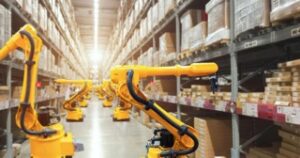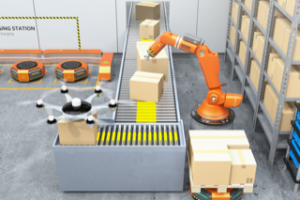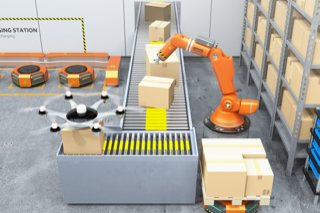 You’d be amazed to know how much revenue the global warehouse automation market generated in 2021!
You’d be amazed to know how much revenue the global warehouse automation market generated in 2021!
As per Statista, the numbers stand at $7.91 billion, with an estimated $51 billion by 2030. The traction was mainly due to the boost in automation efforts to tackle the workforce shortage during the pandemic.
Even with the pandemic subsiding, though, we can see that the market for Robotics for warehouse management is increasing rapidly. Welcome back to the 2nd blog in the series. This time, we’ll look at the different types of robots transforming the warehouse. Let’s start!
Automated Guided Vehicles (AGVs)
Automated Guided Vehicles are self-driving cars that navigate through the warehouse using sensors and pre-programmed routes. They’re typically used for moving large items. With customizable options and easy integration, these cutting-edge machines navigate your facility precisely, reducing labor costs. Say goodbye to manual handling and hello to streamlined efficiency with AGVs.
Check out the rapidly growing portfolio of Rucha Yantra’s AGVs here.
Goods-to-person Robots (GPRs)
Goods-to-person robots are designed to bring items to the work
er rather than the other way around. They’re typically used in e-commerce warehouses where orders must be picked and packed quickly. Additionally, their advanced navigation systems allow them to maneuver through tight spaces. With Goods-to-person Robots, warehouses can keep up with the demand of e-commerce and improve overall efficiency and speed.
Automated Storage & Retrieval Systems (ASRS)
Automated storage and retrieval systems (ASRS) are used to store and retrieve items from high-density storage areas, used in warehouses where space is at a premium, like in urban areas. With ASRS, businesses can store and retrieve items, eliminating the need for manual labor and reducing the risk of human error and delay. This allows companies to save time and money while increasing productivity and accuracy.
Articulated Robotic Arms (ARAs)
Articulated Robotic Arms are another option for warehouse automation.
These robots can be programmed to pick and place items, like boxes or bags. They’re used in warehouses where items must be moved from one spot to another. From manufacturing and assembly to research and development, with advanced sensors, software, and control systems, articulated robotic arms can perform tasks precisely while reducing the chances of manual delay.
Collaborative Robots (CoBots)
Collaborative Bots are designed to work alongside humans rather than replace them. They’re typically used in warehouses where workers need help with repetitive tasks like packing or assembly. With CoBots, manufacturers can also increase productivity and reduce downtime with better accuracy. CoBots are here to revolutionize the manufacturing industry and bring us one step closer to a smarter and more efficient future.
For example, a collaborative bot might help a worker assemble a box of items ready to be shipped.
Which one do you think suits your warehouse the best?
Whether you’re looking for an AGV to move large items around the warehouse or a collaborative bot to help with repetitive tasks, a robot can get the job done. Warehouse automation is here to increase efficiency and productivity.
So, don’t wait any longer. Take your warehouse to the next level, and give your employees a well-deserved productivity boost. Contact Rucha Yantra today, and let us help you find the perfect robot for your warehouse automation needs.
Stay tuned to Rucha Yantra’s Knowledge Corner.


